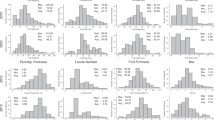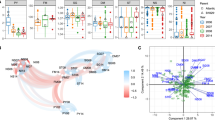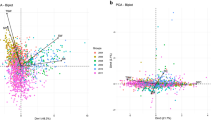Abstract
The conflict between the Mendelian theory of participate inheritance1 and the observation of continuous variation for most traits in nature was resolved in the early 1900s by the concept that quantitative traits can result from segregation of multiple genes, modified by environmental effects2–5. Although pioneering experiments6–9 showed that linkage could occasionally be detected to such quantitative trait loci (QTLs), accurate and systematic mapping of QTLs has not been possible because the inheritance of an entire genome could not be studied with genetic markers7. The use of restriction fragment length polymorphisms10 (RFLPs) has made such investigations possible, at least in principle. Here, we report the first use of a complete RFLP linkage map to resolve quantitative traits into discrete Mendelian factors, in an interspecific back-cross of tomato. Applying new analytical methods, we mapped at least six QTLs controlling fruit mass, four QTLs for the concentration of soluble solids and five QTLs for fruit pH. This approach is broadly applicable to the genetic dissection of quantitative inheritance of physiological, morphological and behavioural traits in any higher plant or animal.
This is a preview of subscription content, access via your institution
Access options
Subscribe to this journal
Receive 51 print issues and online access
$199.00 per year
only $3.90 per issue
Buy this article
- Purchase on Springer Link
- Instant access to full article PDF
Prices may be subject to local taxes which are calculated during checkout
Similar content being viewed by others
References
Mendel, G. Verh. naturf. Ver. in Brunn. 4, (1868).
Johannsen, W. Elemente der exakten Erblichkeitsllehre (Fischer, Jena, 1909).
Nilsson-Ehle, H. Kreuzunguntersuchungen an Hafer und Weizen (Lund, 1909).
East, E. M. Genetics 1, 164–176 (1915).
Wright, S. Evolution and the Genetics of Populations (University of Chicago Press, 1968).
Sax, K. Genetics 8, 552–556 (1923).
Thoday, J. M. Nature 191, 368–369 (1961).
Tanksley, S. D., Medina-Filho, H. & Rick, C. Heredity 49, 11–25 (1982).
Edwards, M. D., Stuber, C. W. & Wendel, J. F. Genetics 116, 113–125 (1987).
Botstein, D., White, R. L., Skolnick, M. & Davis, R. W. Am. J. hum. Genet. 32, 314–331 (1980).
Chmielewski, T. Genet. pol. 9, 97–124 (1968).
Rick, C. M. Hilgardia 42, 493–510 (1974).
Tanksley, S. D. & Hewitt, J. Theor. appl. Genet. 75, 811–823 (1988).
Tanksley, S. D., Miller, J., Paterson, A. & Bernatzky, R. Proc. 18th Stadler Genet. Symp. (in the press).
Lander, E. S. et al. Genomics 1, 174–181 (1987).
Lander, E. S. & Botstein, D. Genetics (in the press).
Ott, J. Analysis of Human Genetic Linkage (Johns Hopkins, Baltimore, 1985).
Simmonds, N. W. Principles of Crop Improvement, 82–85 (Longman, New York, 1981).
Lande, R. Heredity 50, 47–65 (1983).
Shrimpton, A. E. & Robertson, A. Genetics 11, 445–459 (1988).
Yeager, A. F. J. Hered. 18, 263–265 (1927).
Emery, G. C. & Munger, H. M. J. Am. Soc. Hort. Sci. 95, 410–412 (1966).
Zamir, D. & Tadmor, Y. Bot. Gaz. 147, 355–358 (1986).
Tanksley, S. D. in Isozymes in Plant Genetics and Breeding (eds Tanksley, S. D. & Orton, T. J.) 331–338 (Elsevier, Amsterdam, 1983).
Rick, C. M. in Genes, Enzymes and Populations (ed. A. M. Srb) 255–268 (Plenum, New York, 1973).
Harlan, J. R. Crop Sci. 16, 329–333 (1976).
Festing, M. F. W. Inbred Strains in Biomedical Research (Oxford, New York, 1979).
Coyne, J. A. & Charlesworth, B. Heredity 57, 243–246 (1986).
Helentjaris, T. Trends Genet. 3, 217–221 (1987).
Landry, B. S., Kessell, R., Leung, H. & Michelmore, R. W. Theor. appl. Genet. 74, 646–653 (1987).
Burr, B., Burr, F. A., Thompson, K. H., Albertsen, M. C. & Stuber, C. W. Genetics 118, 519–526 (1988).
Chang, C., Bowman, J. L., DeJohn, A. W., Lander, E. S. & Meyerowitz, E. M. Proc. natn. Acad. Sci. U.S.A. 68, 6856–6860.
McCouch, S. R. et al. Theor. appl. Genet. (in the press).
Bonierbale, M. W., Plaisted, R. L. & Tanksley, S. D. Genetics (in the press).
Franklin, I. A. Theor. Papulat. Biol. 11, 60–80 (1977).
Stam, P. Genet. Res. 25, 131–155 (1980).
Kosambi, D. D. Ann. Eugen. 12, 172–175 (1944).
Tanksley, S. D. & Rick, C. M. Theor. appl. Genet. 57, 161–170 (1980).
Author information
Authors and Affiliations
Rights and permissions
About this article
Cite this article
Paterson, A., Lander, E., Hewitt, J. et al. Resolution of quantitative traits into Mendelian factors by using a complete linkage map of restriction fragment length polymorphisms. Nature 335, 721–726 (1988). https://doi.org/10.1038/335721a0
Received:
Accepted:
Issue Date:
DOI: https://doi.org/10.1038/335721a0
This article is cited by
-
Identification of a novel and plant height-independent QTL for coleoptile length in barley and validation of its effect using near isogenic lines
Theoretical and Applied Genetics (2024)
-
QTL Meta-Analysis: An Approach to Detect Robust and Precise QTL
Tropical Plant Biology (2023)
-
Mapping of genomic regions linked to stemphylium blight (Stemphylium botryosum Wallr.) resistance in lentil using linkage mapping and marker-trait association analysis
Euphytica (2023)
-
A Wheat 660 K SNP array-based high-density genetic map facilitates QTL mapping of flag leaf-related traits in wheat
Theoretical and Applied Genetics (2023)
-
Discovery of common loci and candidate genes for controlling salt-alkali tolerance and yield-related traits in Brassica napus L.
Plant Cell Reports (2023)
Comments
By submitting a comment you agree to abide by our Terms and Community Guidelines. If you find something abusive or that does not comply with our terms or guidelines please flag it as inappropriate.



